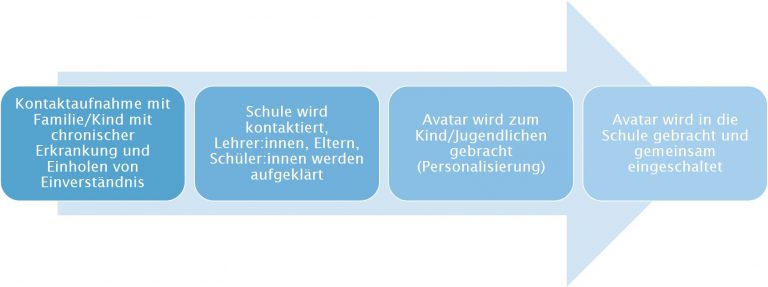To get our avatars into action, we first contact the family of the child with a chronic disease and obtain their consent. Afterwards, the school is contacted, and the teachers, parents and students are informed about the project. Following this step, the avatar is introduced to the child and personalized. Once the child has familiarized themselves with the avatar, it is brought to the school and activated together.

We want to enable children and adolescents with a chronic illness to stay in contact with their classmates and not lose touch in class with the help of the avatar A1. It is important to collect information about the changes that occur through the avatar AV1 in children and adolescents with chronic diseases, in order to enable targeted psychological and educational support in the future. With the help of questionnaires at different time points, we are investigating how the use of the avatar AV1 affects the school participation, sense of belonging, quality of life and self-esteem of children and adolescents with chronic diseases. The study will be conducted only with the consent of the participants and will not affect the child’s medical treatment. Thus, children can receive an avatar without participating in the study and still benefit from the advantages of this therapeutic tool. Within the project, Be PART of it! the approach of PARTicipative research will be pursued, which enables a collaboration between researchers and co-researchers from the very beginning. Children and adolescents with and without chronic illnesses are considered as co-researchers, which has the advantage of including the perspectives of students and letting them shape the research process themselves. Instead of researching about students, research is conducted WITH them. For example, this website was created in collaboration with students from the TGM (Technologisches Gewerbemuseum – Höhere Technische Bundeslehr- u. Versuchsanstalt). The technical expertise of the students should ideally complement the content-related know-how of the project team. The creation of the project website should not only be informative, but also specifically target the student’s needs. Therefore, the creation of the website as well as the entire research process is participatory and should actively involve the students. All these steps are intended to enable children and adolescents to have a better participation in school and in everyday life in the long run. Through close collaboration between researchers and stakeholders, technologies can be further developed and improved to better meet the needs of users and promote inclusion and participation in the school environment.
